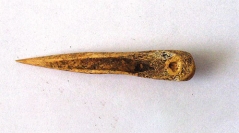

 Comptes Rendus Palevol
10 (1) - Pages 61-70
Comptes Rendus Palevol
10 (1) - Pages 61-70This is a report on the successful application of Enzyme-Linked ImmunoSorbent Assay (ELISA) in archaeozoology, particularly for the taxonomic determination of severely fragmented bone material from archaeological contexts of the locality (Czech Republic) dated to the Central European Neolithic period (approx. 5500–4500 BC). Physical, chemical and biological features of soil deposits in the sites examined are the likely cause of the crumbly consistency of the bone material supplied to the laboratory. These factors dwarfed the ratio of specimens determinable by their physical morphology to 28%, thus limiting the reliability of inferences on the character of the economy practiced in the excavated sites. The mass spectrometric approach is the suitable standard for ancient protein investigation, but the high financial requirements prevent practical adoption of the method for fast and routine identification of bone fragments. One way to more easily and cheaply differentiate the taxons of domestic animals on the basis of bone chips is the ELISA test. In the past, experiments trying to improve the unfavourable ratio by a protein radioimmunoassay (pRIA) method yielded positive results. However, similar outcomes can be achieved by commercially available and therefore less laborious ELISA kits that were originally designed for use in inspections of the food industry.
ELISA, Protein, Neolithic, Archaeozoology, Domestic animal